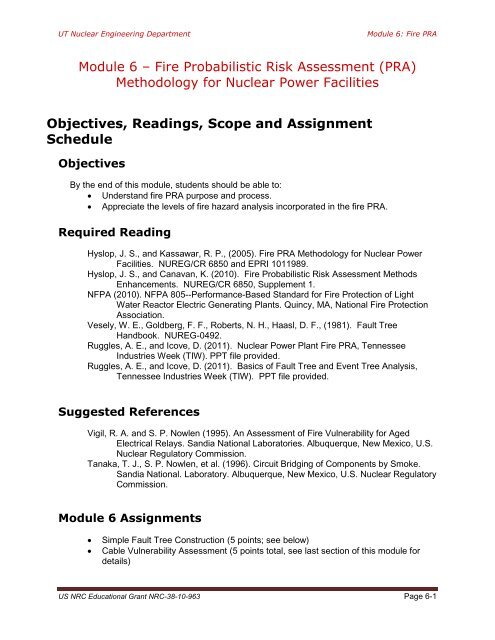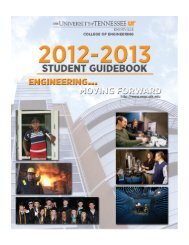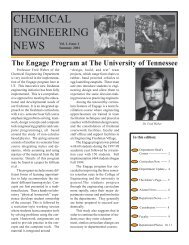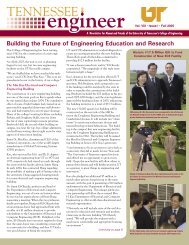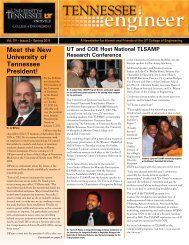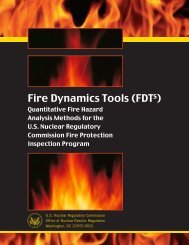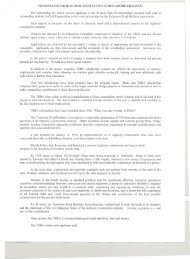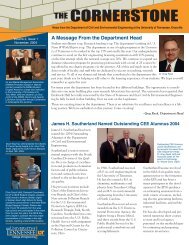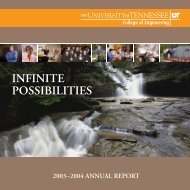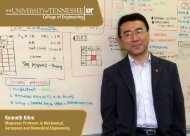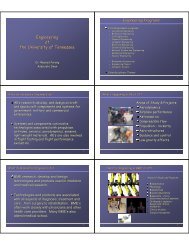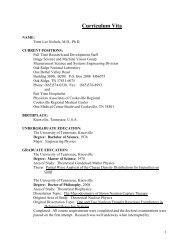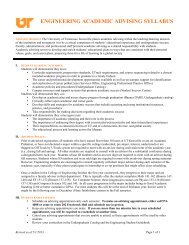Module 6 â Fire Probabilistic Risk Assessment (PRA) Methodology ...
Module 6 â Fire Probabilistic Risk Assessment (PRA) Methodology ...
Module 6 â Fire Probabilistic Risk Assessment (PRA) Methodology ...
Create successful ePaper yourself
Turn your PDF publications into a flip-book with our unique Google optimized e-Paper software.
UT Nuclear Engineering Department<strong>Module</strong> 6: <strong>Fire</strong> <strong>PRA</strong><strong>Module</strong> 6 – <strong>Fire</strong> <strong>Probabilistic</strong> <strong>Risk</strong> <strong>Assessment</strong> (<strong>PRA</strong>)<strong>Methodology</strong> for Nuclear Power FacilitiesObjectives, Readings, Scope and AssignmentScheduleObjectivesBy the end of this module, students should be able to: Understand fire <strong>PRA</strong> purpose and process. Appreciate the levels of fire hazard analysis incorporated in the fire <strong>PRA</strong>.Required ReadingHyslop, J. S., and Kassawar, R. P., (2005). <strong>Fire</strong> <strong>PRA</strong> <strong>Methodology</strong> for Nuclear PowerFacilities. NUREG/CR 6850 and EPRI 1011989.Hyslop, J. S., and Canavan, K. (2010). <strong>Fire</strong> <strong>Probabilistic</strong> <strong>Risk</strong> <strong>Assessment</strong> MethodsEnhancements. NUREG/CR 6850, Supplement 1.NFPA (2010). NFPA 805--Performance-Based Standard for <strong>Fire</strong> Protection of LightWater Reactor Electric Generating Plants. Quincy, MA, National <strong>Fire</strong> ProtectionAssociation.Vesely, W. E., Goldberg, F. F., Roberts, N. H., Haasl, D. F., (1981). Fault TreeHandbook. NUREG-0492.Ruggles, A. E., and Icove, D. (2011). Nuclear Power Plant <strong>Fire</strong> <strong>PRA</strong>, TennesseeIndustries Week (TIW). PPT file provided.Ruggles, A. E., and Icove, D. (2011). Basics of Fault Tree and Event Tree Analysis,Tennessee Industries Week (TIW). PPT file provided.Suggested ReferencesVigil, R. A. and S. P. Nowlen (1995). An <strong>Assessment</strong> of <strong>Fire</strong> Vulnerability for AgedElectrical Relays. Sandia National Laboratories. Albuquerque, New Mexico, U.S.Nuclear Regulatory Commission.Tanaka, T. J., S. P. Nowlen, et al. (1996). Circuit Bridging of Components by Smoke.Sandia National. Laboratory. Albuquerque, New Mexico, U.S. Nuclear RegulatoryCommission.<strong>Module</strong> 6 AssignmentsSimple Fault Tree Construction (5 points; see below)Cable Vulnerability <strong>Assessment</strong> (5 points total, see last section of this module fordetails)US NRC Educational Grant NRC-38-10-963 Page 6-1
UT Nuclear Engineering Department<strong>Module</strong> 6: <strong>Fire</strong> <strong>PRA</strong>1. Preliminary Activity<strong>Fire</strong> probability as determined by ignition sources and frequencies can lead to fire eventsthat have capability to compromise safety systems and lead to fuel damage. The probability forfuel damage is represented in a core damage frequency (CDR). Ignition sources that can leadto damage of cable trays with important control, indication or power functions are a significantportion of the plant fire induced risk. <strong>Fire</strong> damage of switchgear, transformers, motors and otherelectrical components also contributes. Ignition frequencies are well established for manycomponent types, and nuclear power plant fleet wide data are used to form a composite ignitionfrequency chart. This composite chart is used in fire <strong>PRA</strong> assessment. An example of thecomposite ignition frequency data used for <strong>Fire</strong> <strong>PRA</strong> from NUREG CR-6850 is provided in Table6-1.Table 6-1: Example Partial Listing of Ignition Frequencies (NUREG/CR-6850)An ignition event starts a cascade of events that may lead to core damage. Theprobability that an ignition event may lead to core damage is determined through probabilisticrisk assessment (<strong>PRA</strong>). <strong>PRA</strong> methods are known to most nuclear professionals. However, aPowerPoint file (Basics of FT and ET Analysis.PPT) is provided that covers the essentialfeatures of fault tree and event tree analysis used in <strong>PRA</strong> should a tutorial be required. Theapproach to fire <strong>PRA</strong> suggested in NUREG/CR-6850, and supplement, is the emphasis of thismodule. The details of the plant <strong>PRA</strong> are not covered. The way the <strong>PRA</strong> drives priorities in firehazard analysis is emphasized. Only ignition locations that pose significant risk to the plant, asrepresented by CDF, are given complete fire hazard assessments.NRC has continued to escalate use of performance based methods to set priorities forregulation. The goal is to maximize efficacy of regulation in protecting the welfare of the public.US NRC Educational Grant NRC-38-10-963 Page 6-2
UT Nuclear Engineering Department<strong>Module</strong> 6: <strong>Fire</strong> <strong>PRA</strong><strong>PRA</strong> methods are central to performance based regulation. <strong>Fire</strong> <strong>PRA</strong> is currently treated as anaddition to the existing plant <strong>PRA</strong> in NUREG/CR-6850. One would expect a more integratedapproach to emerge as time passes. As a final note, the <strong>PRA</strong> methods are increasinglyimportant to assessing risk in insurance actuarial functions, and this may also motivate use of<strong>PRA</strong> in nuclear power applications going forward.Group activity - For the preliminary activity, the class will discuss the ways a fireignition, progression and fire protection response might influence the power plant, and howerroneous indications in the control room might confuse operators.Author a group report and each student individually submit their copy to M6 <strong>PRA</strong> Modelingin the Assignments area in BlackBoard as well as email to the instructor or teachingassistant by the due date specified in the Course Calendar.2. The <strong>Fire</strong> <strong>PRA</strong> ProcessIn 2011, the generally accepted step-by-step process for modeling fires was made intoan engineering guide by the Society of <strong>Fire</strong> Protection Engineers. The “Guideline forSubstantiating a <strong>Fire</strong> Model for a Given Application” serves now as the engineering standard ofcare for a fire hazard assessment. Over this is another set of recommendations, “PerformanceBased Standard for <strong>Fire</strong> Protection for Light Water Reactor Electric Generating Plants,” NFPA-805 (2010), and NUREG/CR-6850 (2005) with supplement (2010). The performance basedmethods use <strong>PRA</strong> to prioritize the areas of the plant where detailed fire hazard assessments arebeneficial, leading to a tiered approach to engineering evaluation of fire hazard. The mostcritical areas receive full zone model or computational fluid dynamic treatments using CFAST orFDS. Less critical areas are evaluated using spreadsheet tools. Areas of low impact on plantfire risk may be eliminated from the assessment because no critical components reside in thearea, or there is a very low probability of fire.This module presents performance based modeling as it applies to nuclear power plants.The main steps in constructing the fire <strong>PRA</strong> are provided in Figure 6-1a and Figure 6-1b. Theprocess is formalized, with details offered on documentation and work scope execution for sometasks. The sixteen tasks that comprise the process are expected to consume a few man yearsof effort for each plant. This man power estimate assumes a plant <strong>PRA</strong> exists, and that cableroutings are documented and available in an electronic and searchable format. The process isalso leveraged by an existing fire safe shutdown evaluation for the plant. The fire safeshutdown evaluation is not performance based.US NRC Educational Grant NRC-38-10-963 Page 6-3
UT Nuclear Engineering Department<strong>Module</strong> 6: <strong>Fire</strong> <strong>PRA</strong>Figure 6-1a: <strong>Fire</strong> <strong>PRA</strong> Construction Process (Continued in Figure 6-1b).Figure 6-1b: <strong>Fire</strong> <strong>PRA</strong> Construction Process (Continuation from Figure 6-1a).US NRC Educational Grant NRC-38-10-963 Page 6-4
UT Nuclear Engineering Department<strong>Module</strong> 6: <strong>Fire</strong> <strong>PRA</strong>3. <strong>Fire</strong> Hazard Calculations Motivated by <strong>PRA</strong>A PowerPoint file (Nuclear Power Plant <strong>Fire</strong> <strong>PRA</strong>.PPT) first used in a pilot short courseduring Tennessee Industries Week (TIW) is provided. This overview of the fire <strong>PRA</strong> processshows the progression in fire hazard analysis detail as the relative importance of the fire eventto CDF increases. Some areas are eliminated early in the process based on ignition frequencydata, and the importance of components in the area to the plant response. This level ofassessment escalates to more detailed evaluations of fire zone of influence, and severity factorsin scoping fire modeling. Task 11 finally demands detailed fire hazard assessment of areasimportant to the plant risk posed by fire events. Additional consideration of combined influenceof earthquakes with fire, and human reliability occur in the later steps of the process.4. Assignment – <strong>Fire</strong> <strong>PRA</strong> for Nuclear Power PlantsIndividual Activity (5 points):1) Perform a simple fault tree evaluation and show how an ignition frequency would feedinto the probability for failure in the tree.2) Offer a few examples of how unintended actuations due to cable damage couldcompromise the plant integrity.3) List fire ignition frequency items that might be expected to increase with plant age.4) List fire detection and response components that may deteriorate with age, or for whichfailure rates may increase with age.CFAST calculations from other course components, such as module 4, can be placed in contextwith the fire <strong>PRA</strong> process. Cable endurance can be assessed using fire dynamics tools andcable data using plume centerline temperature predictions based on room geometry and fireHRR. This is provided as an example included in the PowerPoint file, “Nuclear Power Plant <strong>Fire</strong><strong>PRA</strong>.”Submit your <strong>Module</strong> 6 Assignment to the M6-<strong>PRA</strong> Modeling assignment space by the duedate for instructor review and grading.US NRC Educational Grant NRC-38-10-963 Page 6-5


